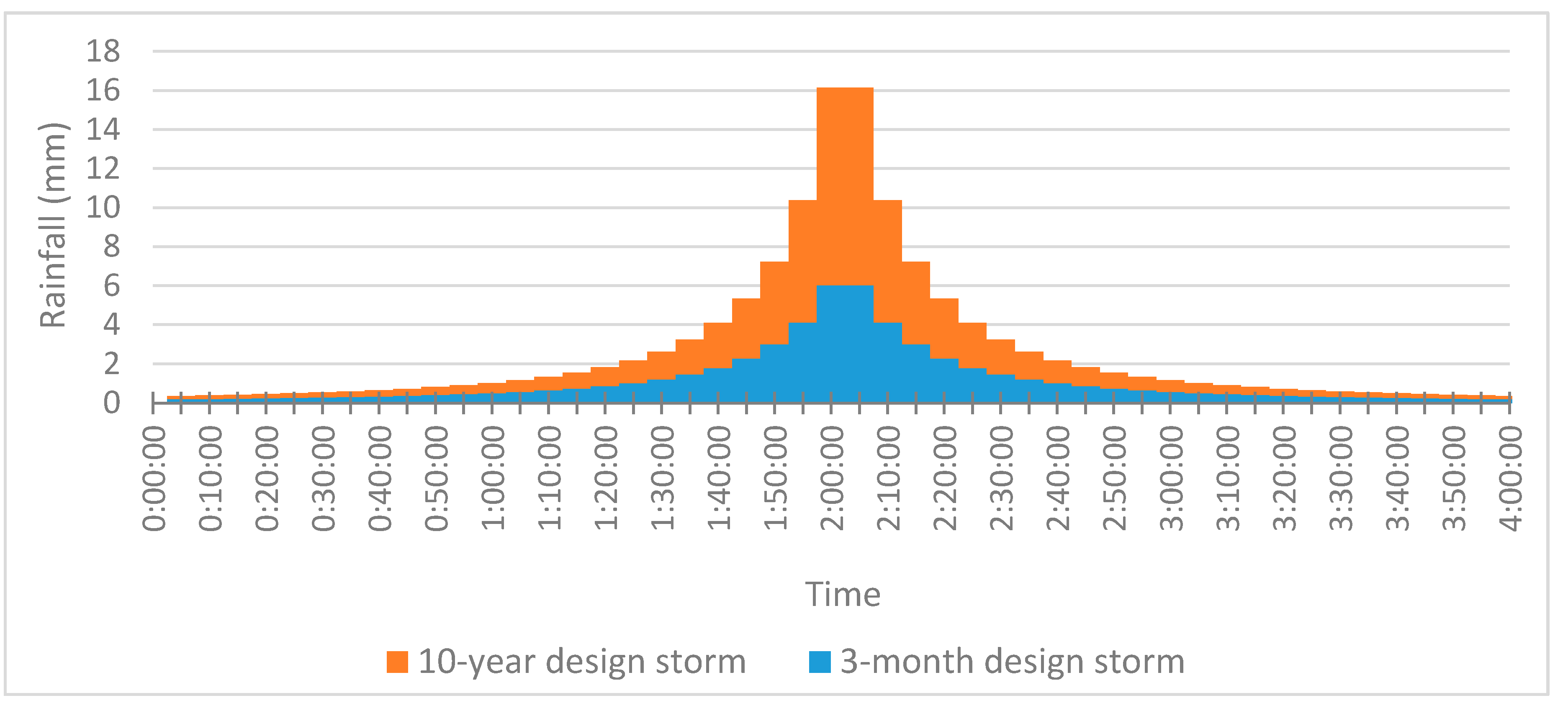Effectiveness of ABC Waters Design Features for Runoff Quantity Control in Urban Singapore
Abstract
:1. Introduction
2. Details of the Site and ABC Waters Design Features
2.1. The Study Site
2.2. Design of ABC Waters Design Features at the Study Site
2.2.1. Bioretention Basins/Rain Gardens
2.2.2. Bioretention Lawns
2.2.3. Vegetated Swales
2.2.4. Gravel Swales
2.3. Monitoring of the Study Site
3. Research Methodology
3.1. Data Collection
3.2. Model Selection
3.3. Preliminary Analysis, Sensitivity Analysis and Model Parameters
3.4. Hydraulic Routing Model and Time Steps
3.5. Scenarios
3.6. Assessments
3.6.1. Peak Flow Reduction and Compliance with Peak Flow Reduction Objectives
- Qr = peak runoff (m3/s)
- C = runoff coefficient (dimensionless)
- I = average rainfall intensity (mm/h)
- A = catchment area (ha).
3.6.2. Effectiveness of Various ABC Waters Design Feature Types in Reducing Peak Flow
4. Results
4.1. Peak Flow Reduction for the 10-Year Design Storm
4.2. Effectiveness of the Various ABC Waters Design Feature Types in Reducing Peak Flow for the 10-Year Design Storm
4.3. Identification of Key Design Elements
4.4. Peak Flow Reduction for the 3-Month Design Storm
4.5. Performance Enhancement through Optimisation
5. Discussion
6. Conclusions
Acknowledgments
Author Contributions
Conflicts of Interest
Appendix A. Optimisation Study on Waterway Ridges
Appendix A.1. Methodology of Optimization Study
| Variable | Value Ranges | |
|---|---|---|
| Minimum | Maximum | |
| Orifice outlet | 0.01 m | Diameter of outlet conduit |
| Gravel storage depth | 0.25 m | 0.8 m |
| Parameter/Case | (A) | (B) |
|---|---|---|
| Optimisation type | Single-objective optimisation of effective C-value | Multi-objective optimisation of effective C-value and cost of gravel storage layer cum orifice outlets |
| Variable to be optimised | Orifice outlet diameters | Gravel storage depth and orifice outlet diameters |
| Number of variables | 18 | 40 |
| Flood cost function | 1012 × total flood volume | Imposed on C-value, which becomes 1 when there is flooding |
| Function for cost of gravel layer 1 and orifice outlets 2 | N.A. | S$55 × (total storage volume)/0.4 × 0.6 + 10 × (number of orifice) |
| Population size | 180 | 400 |
| Crossover rate | 0.9 | 0.9 |
| Mutation rate | 0.2 | 0.2 |
| Number of evaluations | 18,000 | 200,000 |
| Number of generations | 100 | 500 |
Appendix A.2. Results of Orifice Outlet Optimisation

| Scenario | No. of Gravel Storage Units With 100% Utilisation | Average Maximum Utilization for Gravel Storage Units |
|---|---|---|
| Non-optimised base precinct model | 5 | 65.5% |
| Precinct model with optimised orifice outlets | 12 | 78.1% |
Appendix A.3. Results of Orifice Outlet and Gravel Storage Optimisation

Appendix B. Study of Optimum Rain Garden Area and Treated Catchment Area
Appendix B.1. Scope of Study
Appendix B.2. Model Setup

| Land Use Type | Catchment Slope | C-Value | Percentage Imperviousness 1 |
|---|---|---|---|
| Residential | 3% | 0.88 | 78% |
| Commercial | 0.97 | 95% | |
| Mixed (50% residential–50% commercial) | 0.925 | 86% |
| Treated Area (% of Total Site Area) | 10% | 20% | 30% | 35% | 40% | 45% | 50% | 55% | 60% | 65% | 70% |
|---|---|---|---|---|---|---|---|---|---|---|---|
| Total treated area (ha) | 0.4 | 0.8 | 1.2 | 1.4 | 1.6 | 1.8 | 2.0 | 2.2 | 2.4 | 2.6 | 2.8 |
| Treated area for each of the four catchments (ha) | 0.10 | 0.20 | 0.30 | 0.35 | 0.40 | 0.45 | 0.50 | 0.55 | 0.60 | 0.65 | 0.70 |
| Untreated area (ha) | 3.6 | 3.2 | 2.8 | 2.6 | 2.4 | 2.2 | 2.0 | 1.8 | 1.6 | 1.4 | 1.2 |
| Rain Garden Area (% of Total Site Area) | 4% | 5% | 6% | 7% | 8% | 9% | 10% |
|---|---|---|---|---|---|---|---|
| Total rain garden area (ha) | 0.16 | 0.20 | 0.24 | 0.28 | 0.32 | 0.36 | 0.40 |
| Total gravel layer storage volume (m3) | 320 | 400 | 480 | 560 | 640 | 720 | 800 |
| Area for each of the four rain gardens (ha) | 0.04 | 0.05 | 0.06 | 0.07 | 0.08 | 0.09 | 0.1 |
| Gravel layer storage volume for each of the four rain gardens (m3) | 80 | 100 | 120 | 140 | 160 | 180 | 200 |
| Storage curve area for each of the four rain gardens (m2) | 160 | 200 | 240 | 280 | 320 | 360 | 400 |
Appendix B.3. Optimisation of Orifice Outlets and Assessment
| Parameter | Value |
|---|---|
| Variable to be optimised | Orifice outlet diameter |
| Number of variables | 1 |
| Flood cost function | 1012 × total flood volume |
| Population size | 10 |
| Crossover rate | 0.9 |
| Mutation rate | 0.2 |
| Number of evaluations | 300 |
| Number of generations | 30 |
Appendix B.4. Results
Appendix B.4.1. Residential Precinct (C = 0.88)

| Rain Garden Area (% of Total Site Area) | 4% | 5% | 6% | 7% | 8% |
|---|---|---|---|---|---|
| Optimum treated area (% of total site area) | 35% | 40% | 50% | 57.5% | 65% |
| Corresponding optimum effective C-value | 0.592 | 0.589 | 0.535 | 0.488 | 0.427 |
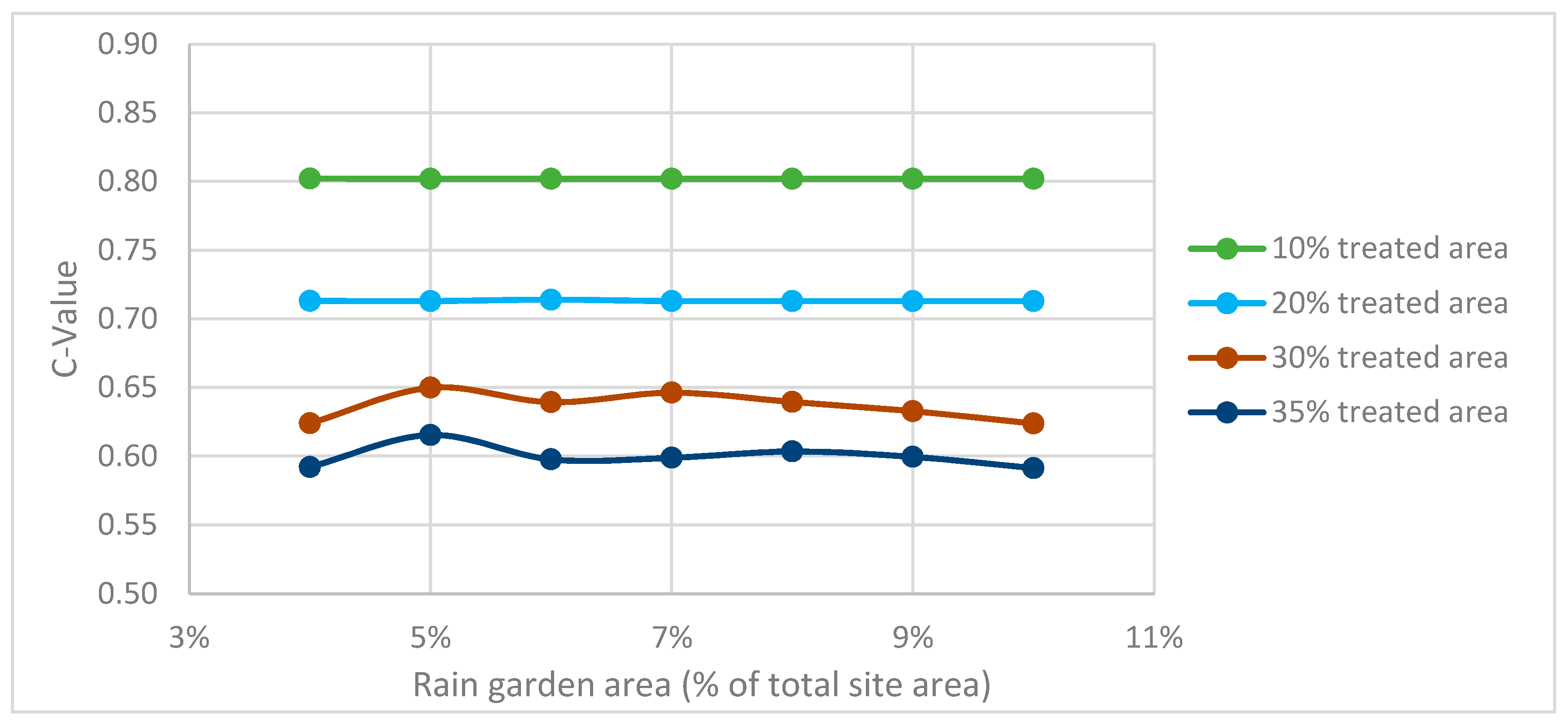
Appendix B.4.2. Commercial Precinct (C = 0.97)
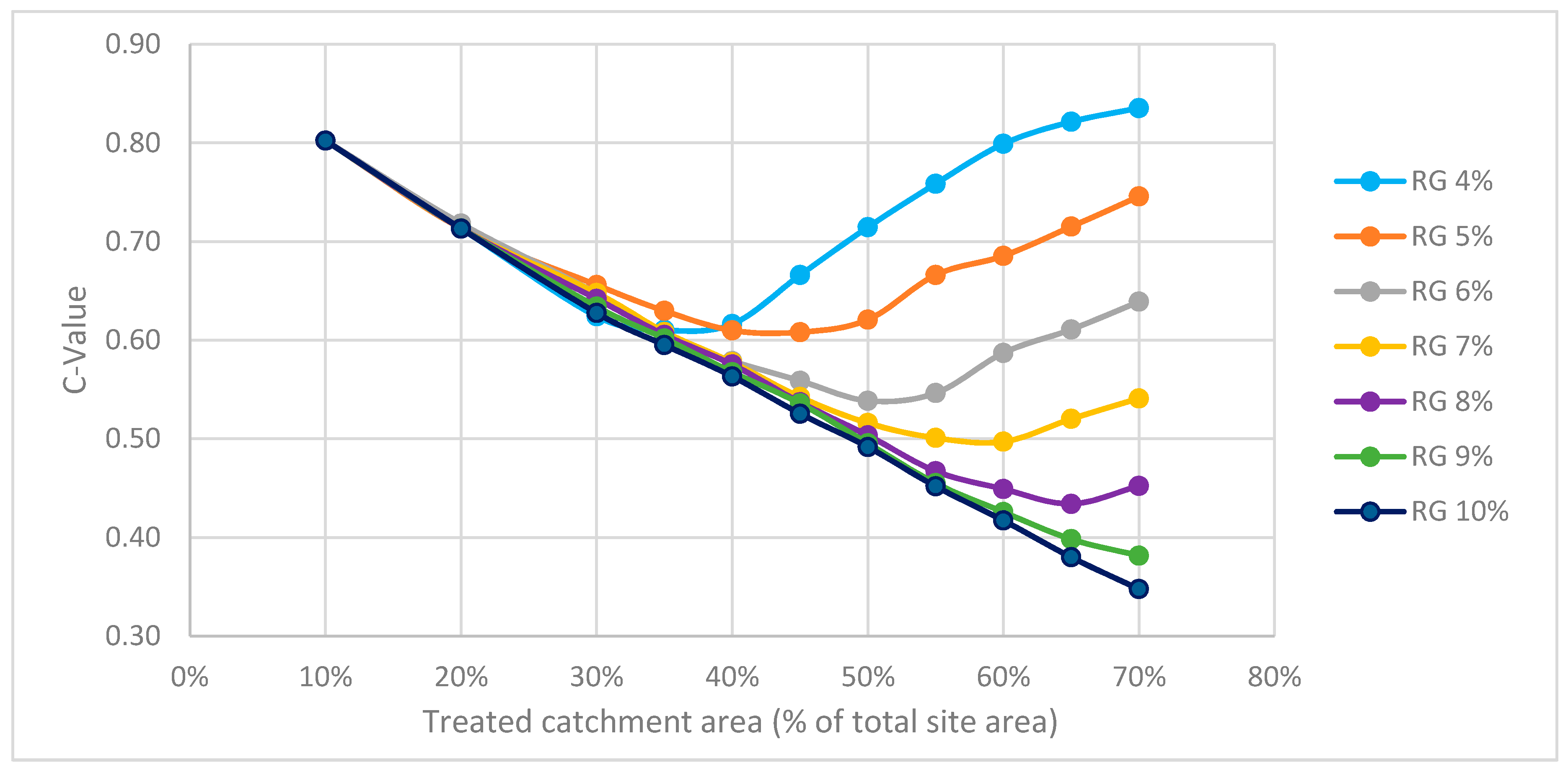
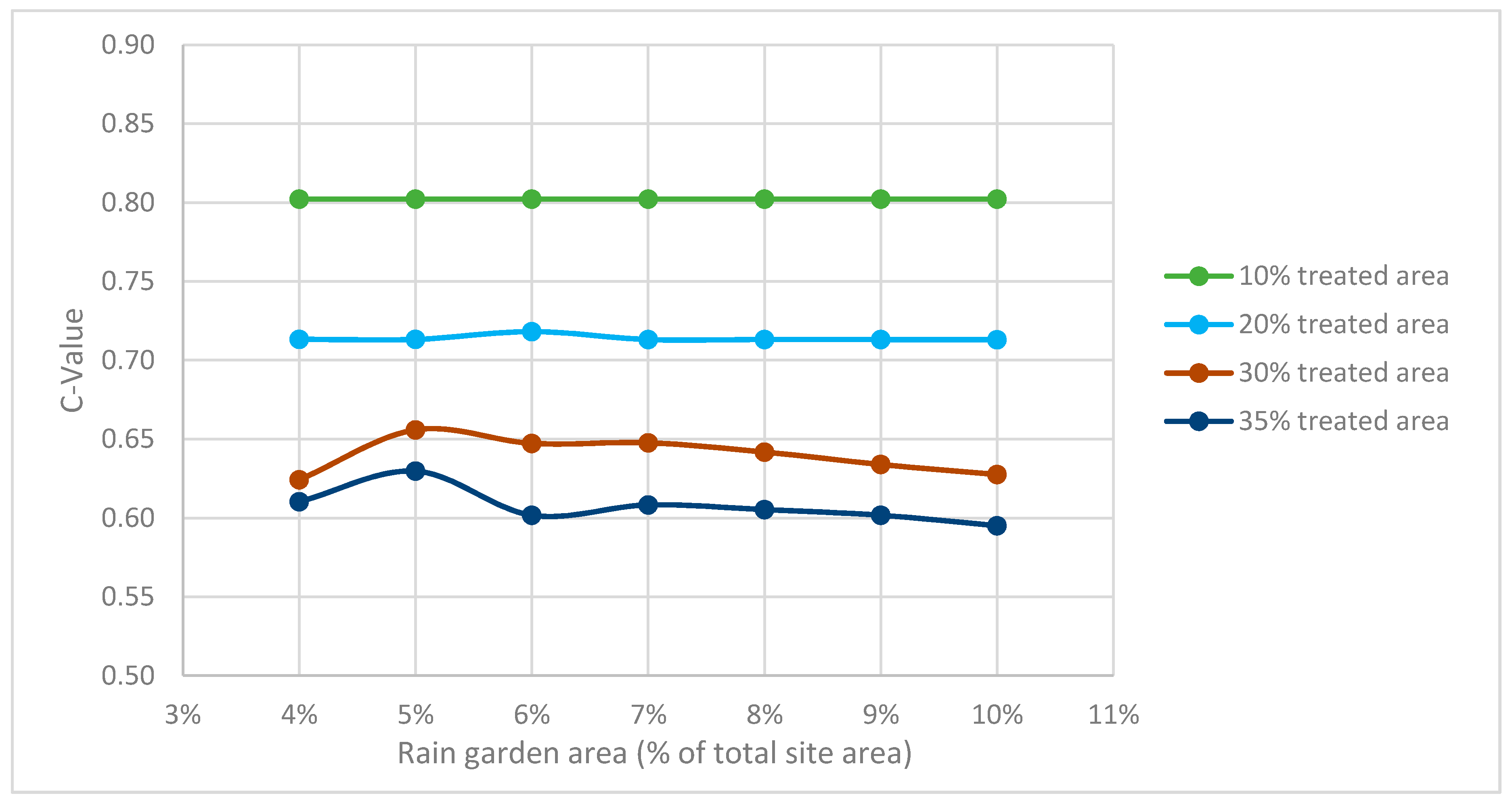
| Rain Garden Area (% of Total Site Area) | 4% | 5% | 6% | 7% | 8% |
|---|---|---|---|---|---|
| Optimum treated area (% of total site area) | 35% | 45% | 50% | 60% | 65% |
| Corresponding optimum effective C-value | 0.610 | 0.608 | 0.539 | 0.497 | 0.434 |
| Increase in optimum effective C-value compared to residential precinct | 0.018 | 0.019 | 0.004 | 0.009 | 0.008 |
Appendix B.4.3. Mixed Residential–Commercial Precinct (C = 0.925)


| Rain Garden Area (% of Total Site Area) | 4% | 5% | 6% | 7% | 8% |
|---|---|---|---|---|---|
| Optimum treated area (% of total site area) | 35% | 40% | 50% | 60% | 65% |
| Corresponding optimum effective C-value | 0.597 | 0.590 | 0.539 | 0.496 | 0.431 |
| Increase in optimum effective C-value compared to residential precinct | 0.005 | 0.001 | 0.004 | 0.007 | 0.004 |
Appendix B.4.4. Recommended Treated Catchment Areas and Rain Garden Sizes for Achieving Effective C = 0.55
| Land Use Type | Rain Garden Area (% of Total Site Area) | ||||||
|---|---|---|---|---|---|---|---|
| 4% | 5% | 6% | 7% | 8% | 9% | 10% | |
| Residential (C = 0.88) | N.A. | N.A. | 45.2% (56.4%) | 42.4% (74.4%) | 41.6% (87.8%) | 41.5% (87.8%) | 41.3% (87.8%) |
| Mixed residential–commercial (C = 0.925) | N.A. | N.A. | 45.8% (55.0%) | 43.3% (72.2%) | 41.9% (87.4%) | 41.8% (87.4%) | 41.4% (87.4%) |
| Commercial (C = 0.97) | N.A. | N.A. | 47.2% (55.0%) | 43.9% (72.1%) | 43.3% (85.5%) | 42.8% (85.5%) | 41.8% (85.5%) |
References
- Inter Governmental Panel on Climate Change. Summary for policymakers. In Climate Change 2013: The Physical Science Basis; Contribution of Working Group I to the Fifth Assessment Report of the Intergovernmental Panel on Climate Change; Stocker, T.F., Qin, D., Plattner, G.-K., Tignor, M., Allen, S.K., Boschung, J., Nauels, A., Xia, Y., Bex, V., Midgley, P.M., Eds.; IPCC: Geneva, Switzerland, 2013. [Google Scholar]
- World Bank Group. Climate Change Knowledge Portal. Available online: http://sdwebx.worldbank.org/climateportal/index.cfm?page=country_historical_climate&ThisRegion=Asia&ThisCCode=SGP (accessed on 6 May 2017).
- United Nations. The World’s Cities in 2016—Data Booklet; ST/ESA/SER.A/392; Department of Economic and Social Affairs, Population Division: New York, NY, USA, 2016. [Google Scholar]
- PUB Singapore’s National Water Agency. Active, Beautiful, Clean Waters Design Guidelines; PUB Singapore’s National Water Agency: Singapore, 2014.
- Fletcher, T.D.; Shuster, W.; Hunt, W.F.; Ashley, R.; Butler, D.; Arthur, S.; Trowsdale, S.; Barraud, S.; Semadeni-Davies, A.; Bertrand-Krajewski, J.-L.; et al. SUDS, LID, BMPS, WSUD and more—The evolution and application of terminology surrounding urban drainage. Urban Water J. 2015, 12, 525–542. [Google Scholar] [CrossRef]
- PUB Singapore’s National Water Agency. Managing Urban Runoff—Drainage Handbook, 1st ed.; Singapore’s National Water Agency and Institution of Engineers: Singapore, 2013.
- PUB Singapore’s National Water Agency. Code of Practice on Surface Water Drainage, 6th ed.; Addendum No. 1: Jun 2013; PUB Singapore’s National Water Agency: Singapore, 2011. Available online: http://www.pub.gov.sg/general/Documents/CP2013/COP_Final.pdf (accessed on 11 September 2014).
- PUB Singapore’s National Water Agency. Engineering Procedures for ABC Waters Design Features; PUB Singapore’s National Water Agency: Singapore, 2014.
- Zhou, Q.; Panduro, T.E.; Thorsen, B.J.; Arnbjerg-Nielsen, K. Adaption to Extreme Rainfall with Open Urban Drainage System: An Integrated Hydrological Cost-Benefit Analysis. Environ. Manag. 2013, 51, 586–601. [Google Scholar] [CrossRef] [PubMed] [Green Version]
- Wang, W.; Zhao, Z.; Qin, H. Hydrological effect assessment of low impact development for urbanized area based on SWMM. Acta Sci. Nat. Univ. Pekin. 2012, 48, 303–309. [Google Scholar]
- Jia, H.; Lu, Y.; Shaw, L.Y.; Chen, Y. Planning of LID–BMPs for urban runoff control: The case of Beijing Olympic Village. Sep. Purif. Technol. 2012, 84, 112–119. [Google Scholar] [CrossRef]
- Tang, Y. Study of urban stormwater runoff BMPs Planning with support of SUSTAIN system. In School of Environment; Tsinghua University: Beijing, China, 2010. [Google Scholar]
- Mugume, S.N.; Melville-Shreeve, P.; Gomez, D.; Butler, D. Multifunctional urban flood resilience enhancement strategies. Proc. Inst. Civ. Eng. Water Manag. 2016, 169, 115–127. [Google Scholar] [CrossRef]
- Jato-Espino, D.; Charlesworth, S.; Bayon, J.; Warwick, F. Rainfall–Runoff Simulations to Assess the Potential of SuDS for Mitigating Flooding in Highly Urbanized Catchments. Int. J. Environ. Res. Public Health 2016, 13, 149. [Google Scholar] [CrossRef] [PubMed]
- Dietz, M.E.; Clausen, J.C. A Field Evaluation of Rain Garden Flow and Pollutant Treatment. Water Air Soil Pollut. 2005, 167, 123–138. [Google Scholar] [CrossRef]
- Davis, A.P. Field Performance of Bioretention: Hydrology Impacts. J. Hydrol. Eng. 2008, 13, 90–95. [Google Scholar] [CrossRef]
- Hunt, W.F.; Smith, J.T.; Jadlocki, S.J.; Hathaway, J.M.; Eubanks, P.R. Pollutant Removal and Peak Flow Mitigation by a Bioretention Cell in Urban Charlotte, N.C. J. Environ. Eng. 2008, 134, 403–408. [Google Scholar] [CrossRef]
- Winston, R.J.; Dorsey, J.D.; Hunt, W.F. Quantifying volume reduction and peak flow mitigation for three bioretention cells in clay soils in northeast Ohio. Sci. Total Environ. 2016, 553, 83–95. [Google Scholar] [CrossRef] [PubMed]
- Davis, A.P.; Hunt, W.F.; Traver, R.G.; Clar, M. Bioretention Technology: Overview of Current Practice and Future Needs. J. Environ. Eng. 2009, 135, 109–117. [Google Scholar] [CrossRef]
- Texas A&M Agrilife Extension. Texas A&M AgriLife Ecological Engineering Program. Available online: http://agrilife.org/lid/projects/lid/rain-garden-and-detention-pond (accessed on 2 July 2017).
- Liu, J.; Sample, D.; Bell, C.; Guan, Y. Review and Research Needs of Bioretention Used for the Treatment of Urban Stormwater. Water 2014, 6, 1069–1099. [Google Scholar] [CrossRef]
- Hatt, B.E.; Fletcher, T.D.; Deletic, A. Hydrologic and pollutant removal performance of stormwater biofiltration systems at the field scale. J. Hydrol. 2009, 365, 310–321. [Google Scholar] [CrossRef]
- Lucke, T.; Nichols, P.W.B. The pollution removal and stormwater reduction performance of street-side bioretention basins after ten years in operation. Sci. Total Environ. 2015, 536, 784–792. [Google Scholar] [CrossRef] [PubMed]
- Atelier Dreiseitl Asia Pte Ltd. Hydraulic Calculation Report for Pilot ABC Waters Project at Punggol East c39 Housing Precinct and Common Green; PUB Singapore’s National Water Agency: Singapore, 2015.
- Meteorological Service Singapore. Climate of Singapore. Available online: http://www.weather.gov.sg/climate-climate-of-singapore (accessed on 3 July 2017).
- National Environment Agency. Weather Statistics. Available online: http://www.nea.gov.sg/weather-climiate./climate/weather-statistics (accessed on 3 July 2017).
- Guo, J.C.Y. Cap-Orifice as a Flow Regulator for Rain Garden Design. J. Irrig. Drain. Eng. 2012, 138, 198–202. [Google Scholar] [CrossRef]
- United States Environmental Protection Agency. Storm Water Management Model (SWMM). 2014. Available online: http://www2.epa.gov/water-research/storm-water-management-model-swmm (accessed on 3 March 2015).
- Gironás, J.; Roesner, L.A.; Davis, J.; Rossman, L.A.; Supply, W. Storm Water Management Model Applications Manual; National Risk Management Research Laboratory, Office of Research and Development, US Environmental Protection Agency: Cincinnati, OH, USA, 2009.
- Aron, G.; Kibler, D.F. Pond Sizing for Rational Formula Hydrographs. J. Am. Water Res. Assoc. 1990, 26, 255–258. [Google Scholar] [CrossRef]
- Shuy, E.B. Derivation of Hydrological Curves for ABC Waters Design Features; PUB Singapore’s National Water Agency: Singapore, 2012.
- Goh, X.P. Broader environmental impact of runoff control using SuDS in the context of urban development in Singapore. In Water Science and Engineering; UNESCO-IHE Institute for Water Education: Delft, The Netherlands, 2015. [Google Scholar]
- Australian Government. Stakeholder Annual Report; Cooperative Research Centre for Water Sensitive Cities Ltd.: Clayton, Australia, 2017.
- Pathirana, A. SWMM5-EA—A tool for learning optimization of urban drainage and sewerage systems with genetic algorithms. In Proceedings of the 11th Innternational Conference on Hydroinformatics, New York, NY, USA, 17–21 August 2014; CUNY Academic Works: New York, NY, USA, 2014. [Google Scholar]
- Storn, R. On the usage of differential evolution for function optimization. Presented at the North American Fuzzy Information Processing Society, Berkeley, CA, USA, 19–22 June 1996. [Google Scholar]
- Goh, X.P.; Radhakrishnan, M.; Pathirana, A.; Zevenbergen, C. Effectiveness of runoff control legislation and Active, Beautiful, Clean (ABC) Waters design features in Singapore. Water 2017. submitted. [Google Scholar]
- Poullain, J. Estimating Storm Water Runoff; PDH online; PDH Centre: Fairfax, VA, USA, 2012. [Google Scholar]
- PUB Singapore’s National Water Agency. Certification Critieria. 2017. Available online: https://www.pub.gov.sg/abcwaters/certification/criteria (accessed on 6 June 2017).
- PUB Singapore’s National Water Agency. Certification. 2017. Available online: https://www.pub.gov.sg/abcwaters/certification (accessed on 6 June 2017).
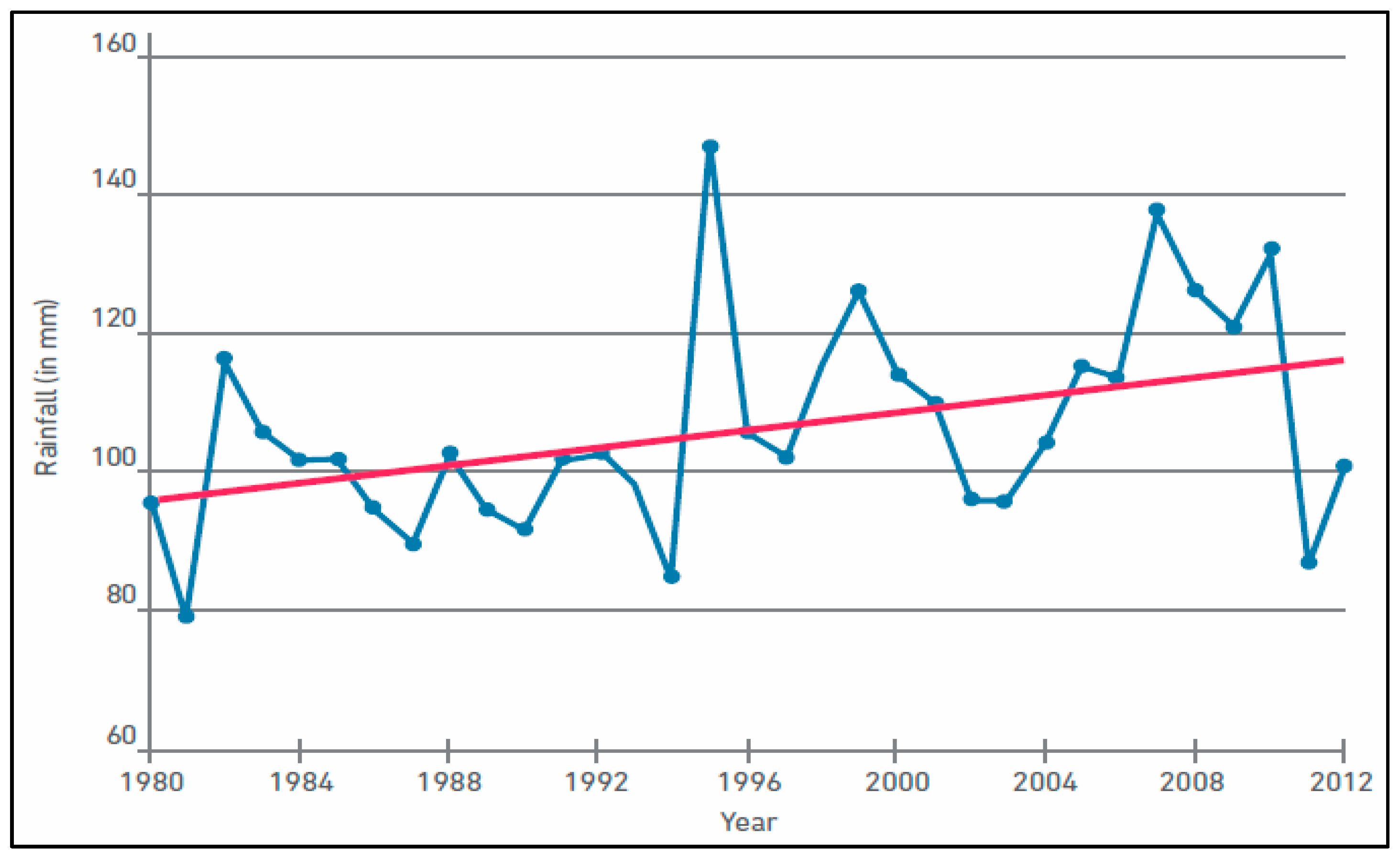
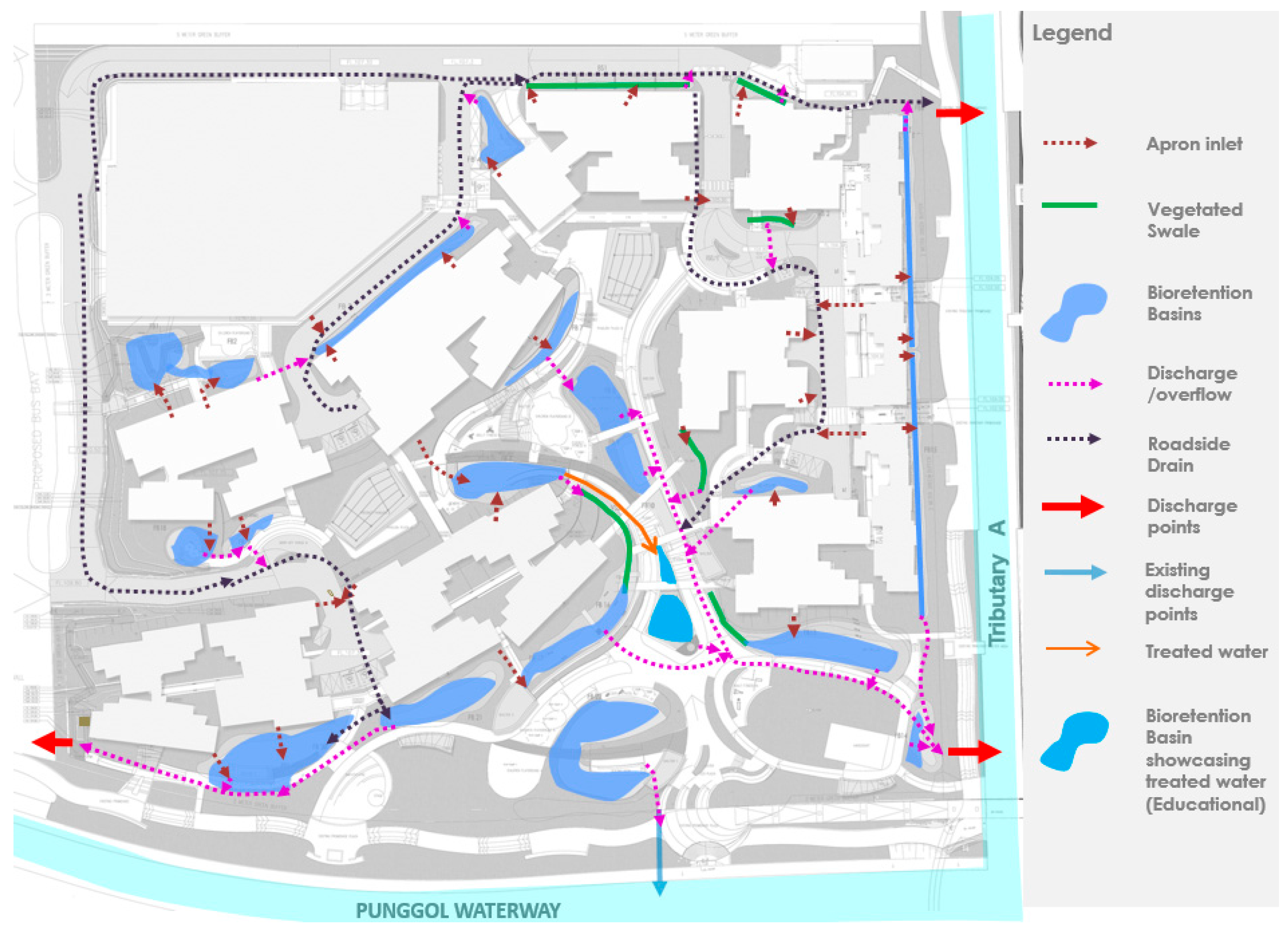

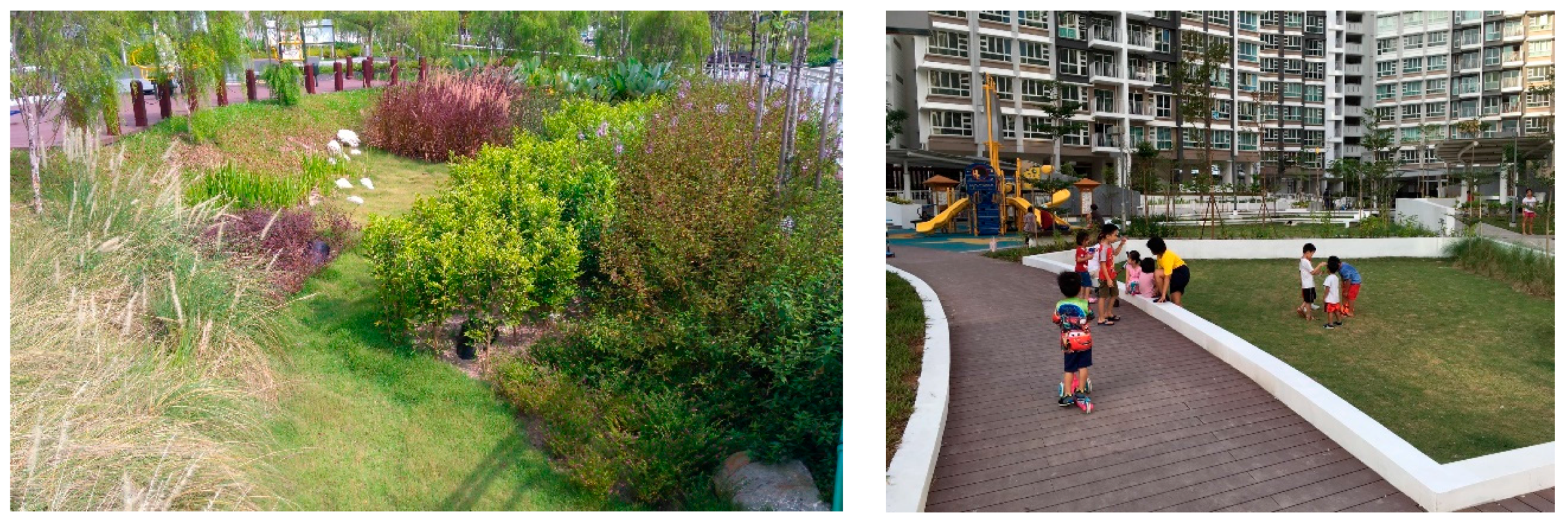
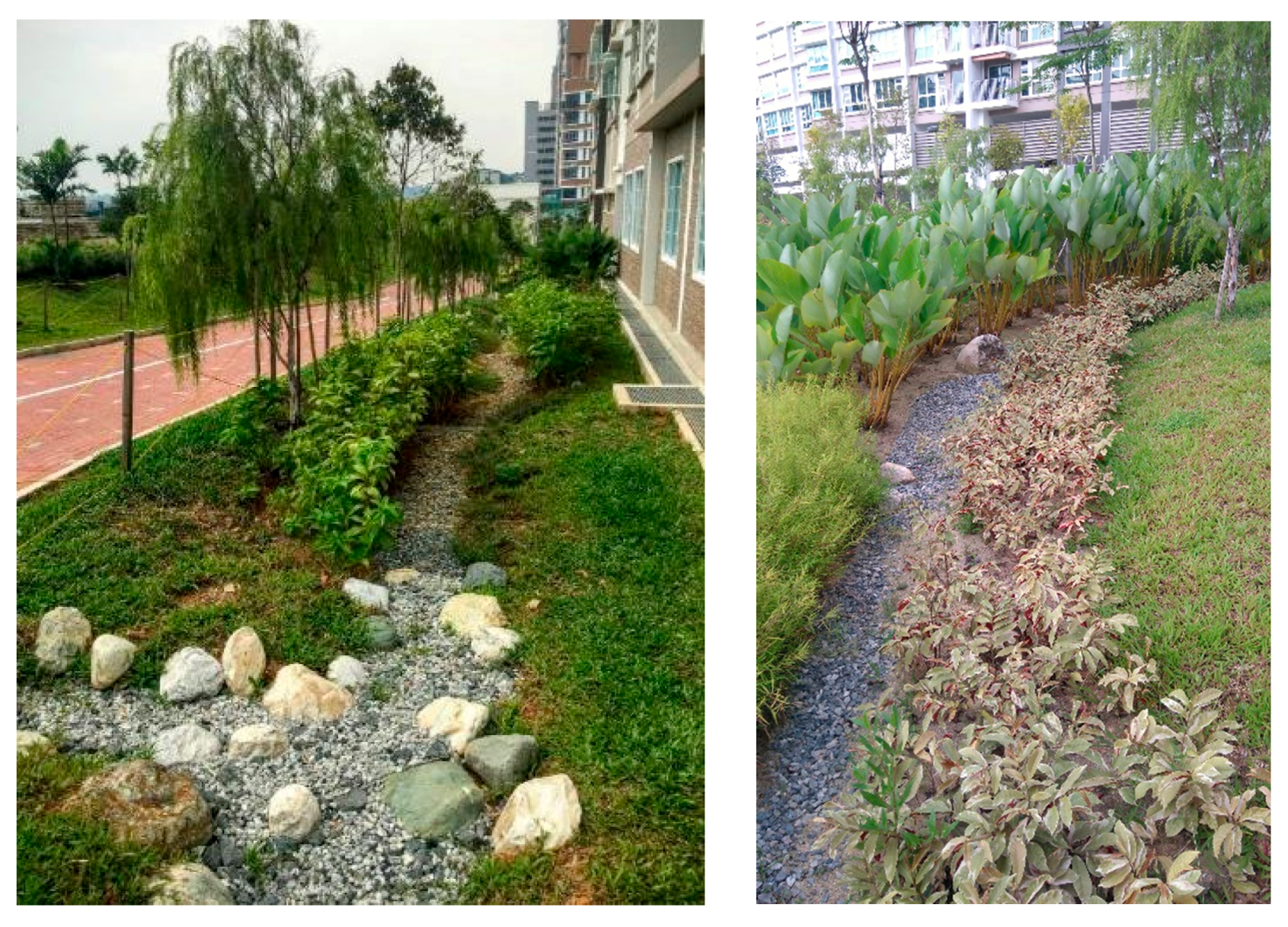


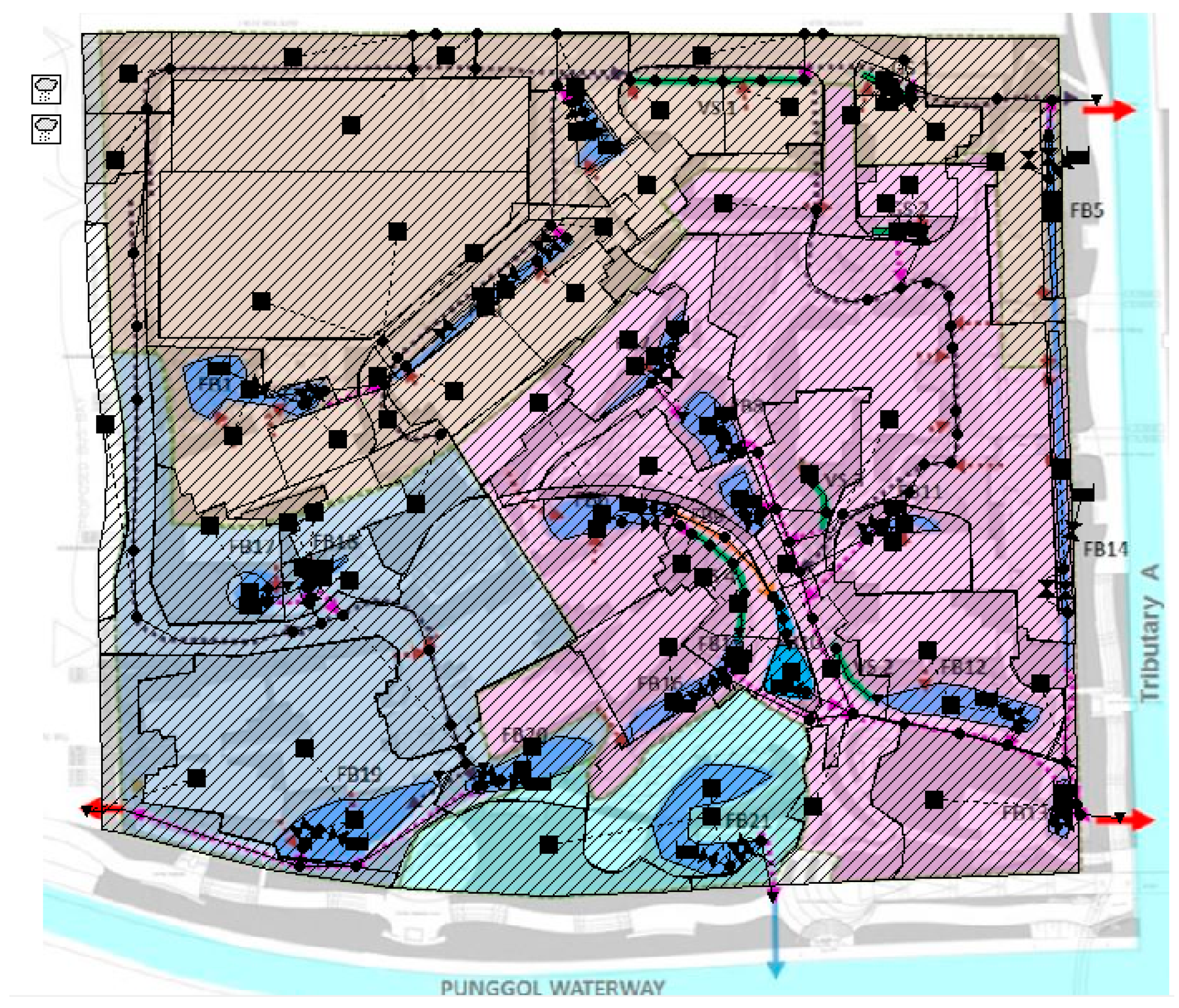
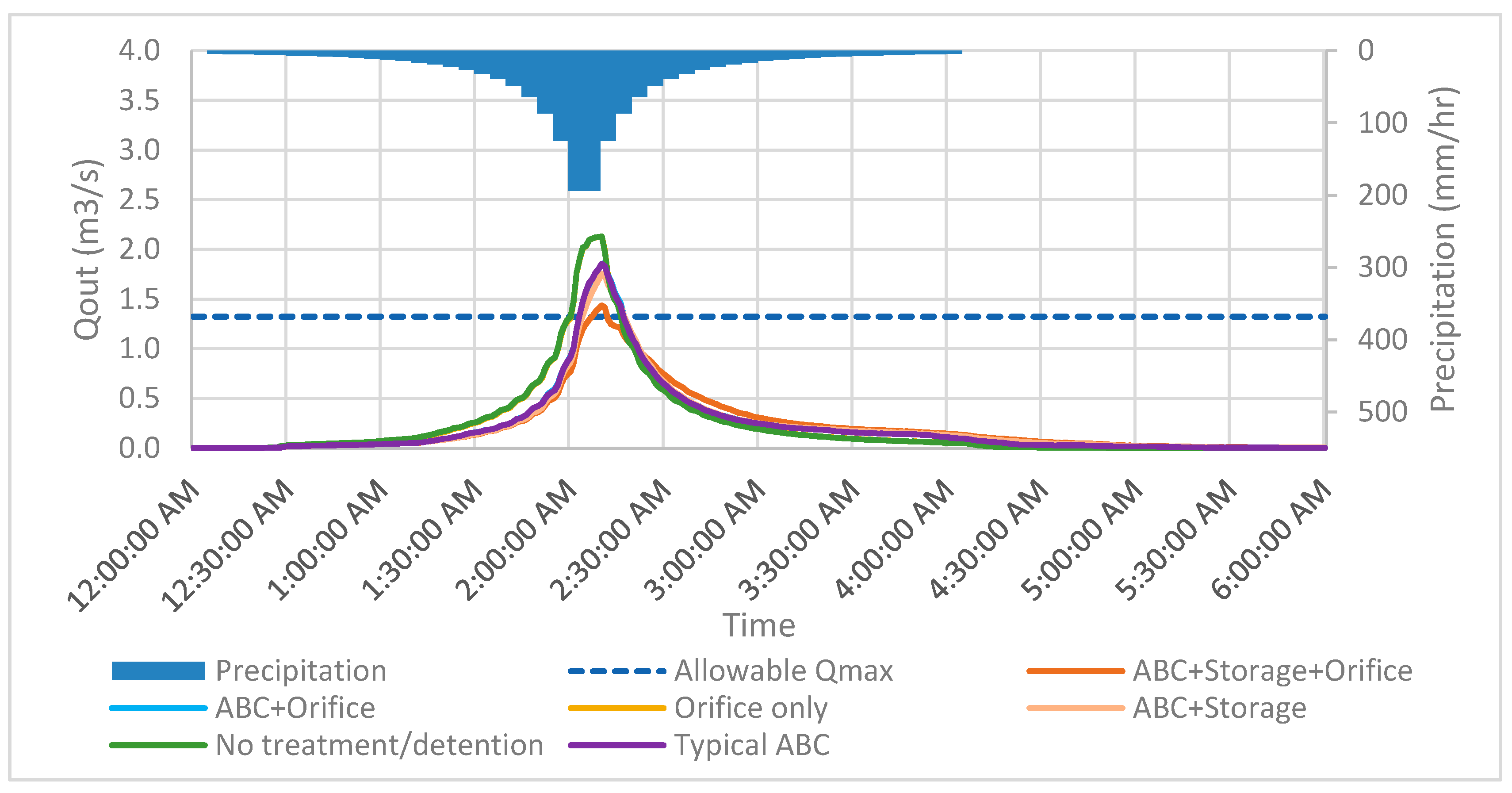
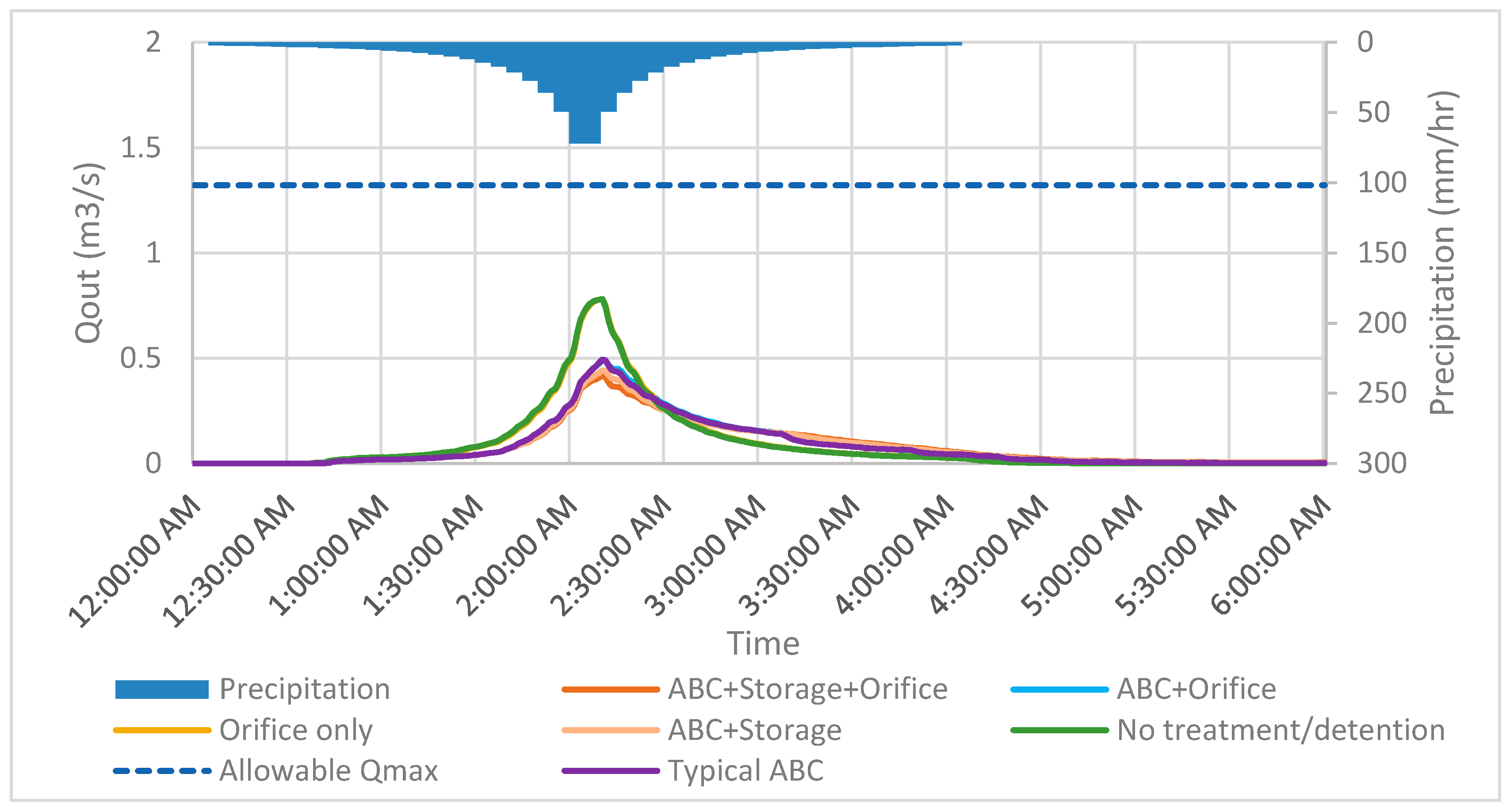
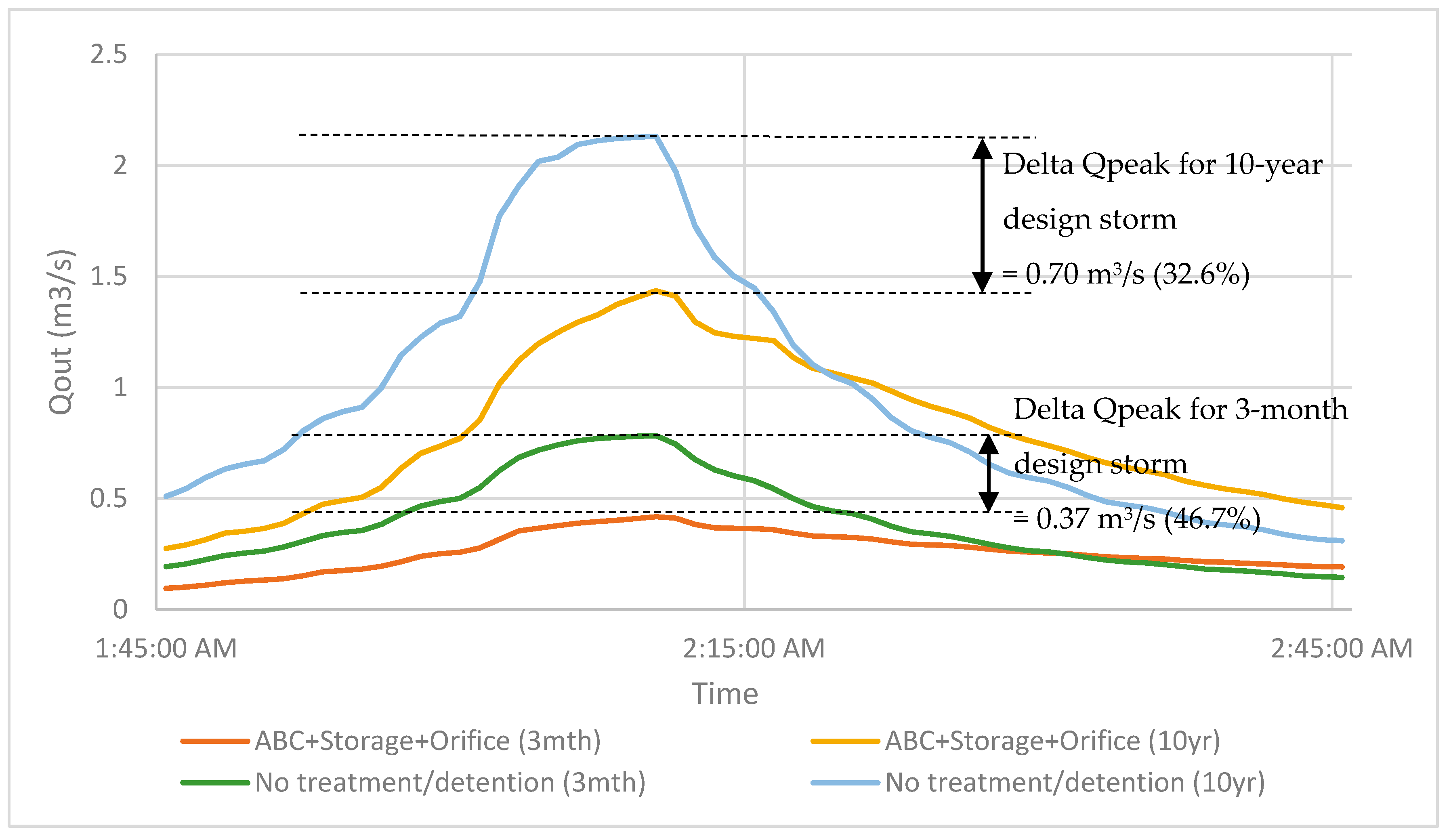
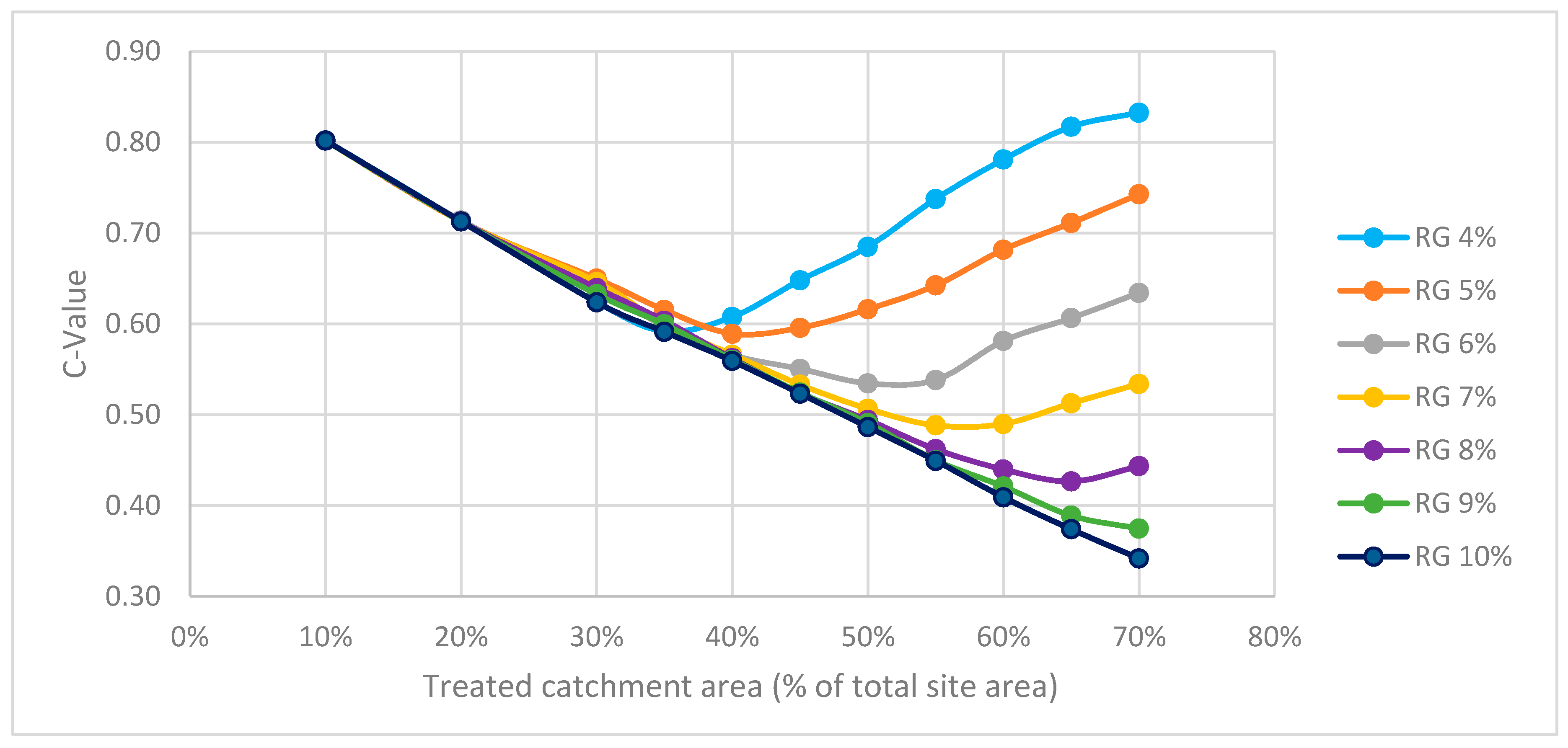
| S/N | Scenario Description | Remarks |
|---|---|---|
| 1 | Precinct without any detention (i.e., conventional design without ABC Waters features, gravel storage or orifice outlets) | To assess performance of the conventional design |
| 2 | Precinct without ABC Waters features but with orifice outlets from the respective subcatchments | To assess effectiveness of orifice outlets alone in reducing peak flow |
| 3 | Precinct with typical design of ABC Waters features implemented in Singapore (i.e., rain gardens and swales without orifice outlets and gravel storage layer) | To assess performance of the precinct if typical design of ABC Waters features was used |
| 4 | Precinct with ABC Waters features coupled with orifice outlets but without gravel storage | To determine importance of gravel storage in reducing peak flow |
| 5 | Precinct with ABC Waters features coupled with gravel storage but without orifice outlets | To determine importance of orifice outlets in reducing peak flow |
| 6 | Precinct with ABC Waters features coupled with gravel storage and orifice outlets | Base model that corresponds to the actual constructed precinct |
| S/N | Label | Scenario | Qmax (m3/s) | Reduction * in Qmax | Effective C-Value |
|---|---|---|---|---|---|
| 1 | No treatment/detention | Precinct without any treatment or detention | 2.13 | 0% | 0.89 |
| 2 | Orifice only | Precinct with orifice outlets only | 2.13 | 0% | 0.89 |
| 3 | Typical ABC | Precinct with typical design of ABC Waters features implemented in Singapore | 1.85 | 13.0% | 0.77 |
| 4 | ABC + Orifice | Precinct with ABC Waters features and orifice outlets but without gravel storage | 1.86 | 12.6% | 0.77 |
| 5 | ABC + Storage | Precinct with ABC Waters features and gravel storage but without orifice outlets | 1.75 | 17.7% | 0.73 |
| 6 | ABC + Storage + Orifice | Precinct with ABC Waters features coupled with gravel storage and orifice outlet | 1.44 | 32.6% | 0.60 |
| Design Feature Type | Average Peak Flow Reduction (%) | Average Normalised Peak Flow Reduction (%) |
|---|---|---|
| Rain gardens * | 39% | 47% |
| Gravel swales | 9% | 25% |
| Vegetated swales | 0% | 0% |
| S/N | Scenario | 3-Month Design Storm | 10-Year Design Storm | ||||
|---|---|---|---|---|---|---|---|
| Qmax (m3/s) | Reduction * in Qmax (%) | C-Value | Qmax (m3/s) | Reduction * in Qmax (%) | C-Value | ||
| 1 | No treatment/detention | 0.78 | 0% | 0.89 | 2.13 | 0% | 0.89 |
| 2 | Orifice only | 0.78 | 0% | 0.89 | 2.13 | 0% | 0.89 |
| 3 | Typical ABC | 0.49 | 36.8% | 0.56 | 1.85 | 13.0% | 0.77 |
| 4 | ABC + Orifice | 0.49 | 37.3% | 0.56 | 1.86 | 12.6% | 0.77 |
| 5 | ABC + Storage | 0.44 | 43.2% | 0.51 | 1.75 | 17.7% | 0.73 |
| 6 | ABC + Storage + orifice | 0.42 | 46.7% | 0.47 | 1.44 | 32.6% | 0.60 |
© 2017 by the authors. Licensee MDPI, Basel, Switzerland. This article is an open access article distributed under the terms and conditions of the Creative Commons Attribution (CC BY) license (http://creativecommons.org/licenses/by/4.0/).
Share and Cite
Yau, W.K.; Radhakrishnan, M.; Liong, S.-Y.; Zevenbergen, C.; Pathirana, A. Effectiveness of ABC Waters Design Features for Runoff Quantity Control in Urban Singapore. Water 2017, 9, 577. https://doi.org/10.3390/w9080577
Yau WK, Radhakrishnan M, Liong S-Y, Zevenbergen C, Pathirana A. Effectiveness of ABC Waters Design Features for Runoff Quantity Control in Urban Singapore. Water. 2017; 9(8):577. https://doi.org/10.3390/w9080577
Chicago/Turabian StyleYau, Wing Ken, Mohanasundar Radhakrishnan, Shie-Yui Liong, Chris Zevenbergen, and Assela Pathirana. 2017. "Effectiveness of ABC Waters Design Features for Runoff Quantity Control in Urban Singapore" Water 9, no. 8: 577. https://doi.org/10.3390/w9080577





